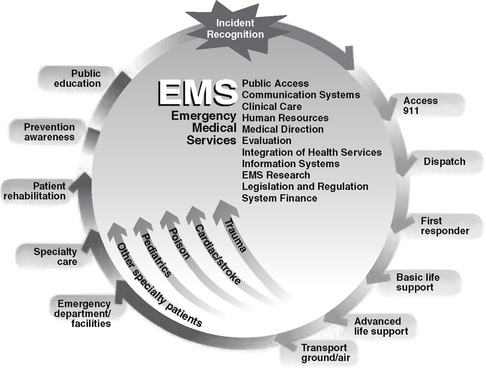CHAPTER 42 Emergency Patient Transfer and Transport
I. EMERGENCY MEDICAL SERVICES SYSTEM
A. Components
1. A comprehensive emergency medical services (EMS) system consists of multiple elements ( Fig. 42-1)
B. Selected Definitions
2) Active role in function and management of the service as it relates to patient care activities; several terms refer to the activities involved in medical oversight (Table 42-1)
II. INTERFACILITY TRANSPORT
A. Selected Definitions
a. Level of transport care provided to patients with an immediate life-threatening illness or injuries associated with single or multiple organ system failure
4) High level of medical direction and sophistication of care because of patient’s complex medical problems
3. Interfacility transfer (IFT)
b. Sending facility needs to determine appropriate personnel based on local or institutional protocols and regulated scope of practice for all provider levels
c. Levels: examples are provided of the types of needs the patient may have and the level of care likely to be required at each level as recommended by the National Highway Traffic Safety Administration
5) Unstable
b) Deteriorating or likely to deteriorate (e.g., patients who require invasive monitoring, intra-aortic balloon pump)
5. Specialty care transport (SCT): defined by Centers for Medicare and Medicaid Services
a. IFT of a critically injured or ill beneficiary by a ground ambulance vehicle including the provision of medically necessary supplies and services, at a level of service beyond the scope of the EMT (Emergency Medical Technician)-Paramedic
b. Necessary when a beneficiary’s condition requires ongoing care that must be furnished by one or more health professionals in an appropriate specialty area (e.g., emergency or critical care nursing, emergency medicine, respiratory care, cardiovascular care, or a paramedic with additional training)
B. Emergency Medical Treatment and Active Labor Act (EMTALA) (see Chapter 44)
1) Patients requiring critical interventions should be provided those interventions in the most expeditious manner possible
2) Patients who are stable should be transported in a manner that best addresses the needs of the patient and the system
3) Patients with critical injuries or illnesses resulting in unstable vital signs require transport by the fastest available modality, and with a transport team that has the appropriate level of care capabilities, to a center capable of providing definitive care
4) Patients with critical injuries or illnesses should be transported by a team that can provide intratransport critical care services
5) Patients who require high-level care during transport, but who do not have time-critical illnesses or injuries, may be candidates for ground critical care transport (i.e., by a specialized ground critical care transport vehicle with level of care exceeding that of local EMS) if such service is available and logistically feasible
2. Level of service: patient condition and treatment needs en route must determine the level of service
a. Scope of practice for each level of service varies among states, regions, and counties within the states
c. Advanced Life Support (ALS): the provision of an assessment by an ALS provider and/or the provision of one or more ALS interventions
d. Other common levels of providers include Intermediate Life Support (ILS) and those with additional privileges and responsibilities
1) Required when the patient’s condition requires ongoing care that must be furnished by one or more health professionals in an appropriate specialty area
3. Transport team personnel: crew members should possess skills and knowledge appropriate to the level of care that the patient requires during transport
a. Must be qualified to continue advanced level of assessment and intervention initiated at referring facility
a. Anticipate necessary supplies, including medications, to address the need of patients during transport
c. Specialized equipment and medications (beyond the basics used to provide routine EMS) must be provided by the sending facility
Get Clinical Tree app for offline access





